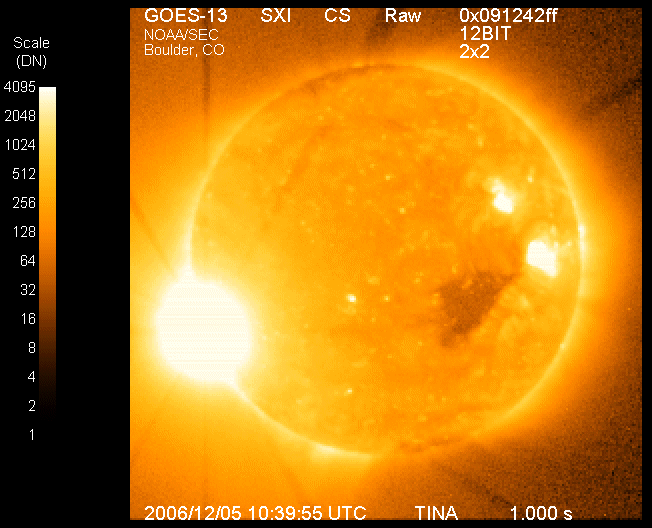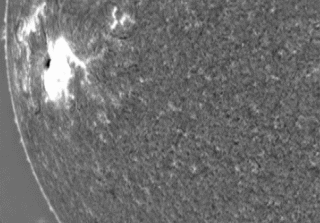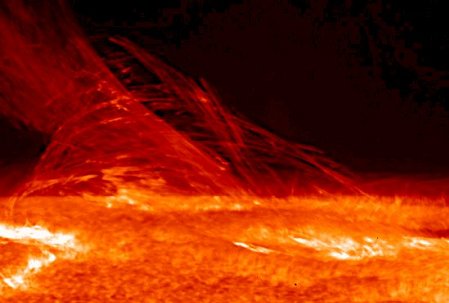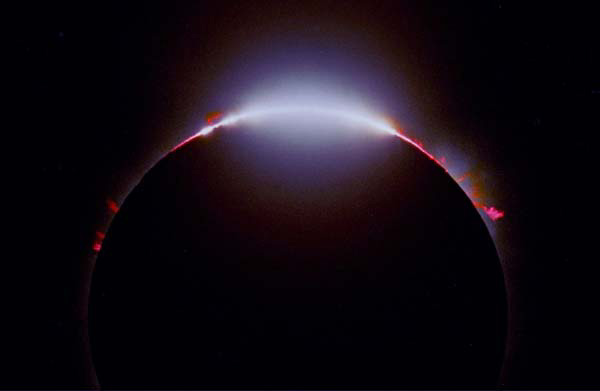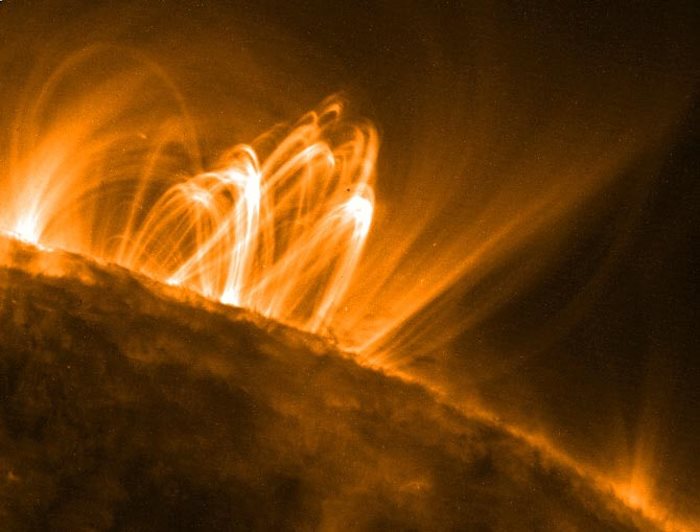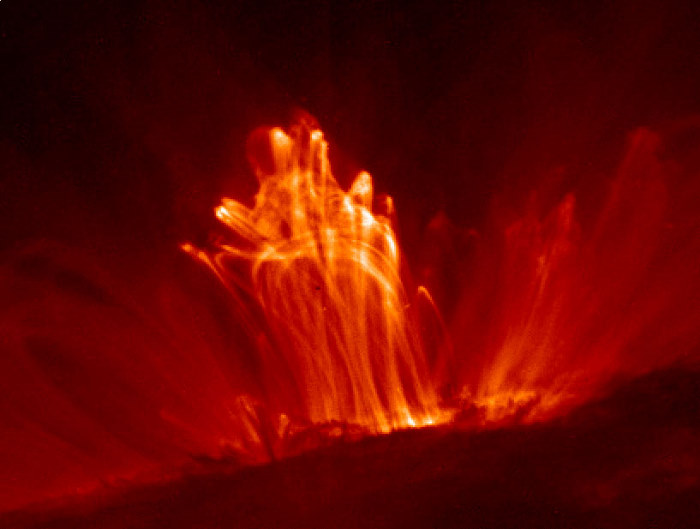|
The Enigmas on the Sun |
||
|
Dec 05, 2006 Earth-orbiting satellites detected a major X9-class solar flare this morning at 1035 UT (5:35 a.m. EST). The source: big, new sunspot 930*, which is emerging over the Sun's eastern limb. GOES-13 captured this X-ray image of the blast:
Because of the
sunspot's location near the limb, the flare
was not Earth-directed. Future eruptions could be,
however, because the
Sun's spin is turning the spot toward Earth. Sunspot
930 will be visible
for the next two weeks as it glides across the solar
disk.
SOURCE: NASA Space Weather Space.com |
||
|
Dec 08, 2006 When sunspot 930 exploded on Dec. 6th, producing an X6-category flare, it also created a tsunami-like shock wave that rolled across the face of the sun, wiping out filaments and other structures in its path. An H-alpha telescope in New Mexico operated by the National Solar Observatory (NSO) recorded the action:
"These large scale blast waves occur infrequently, however, are very powerful," says Dr. K. S. Balasubramaniam of the National Solar Observatory. "They quickly propagate in a matter of minutes covering the whole sun and apparently sweeping away filamentary material." Researchers are unsure whether the filaments were blown off or were compressed so they were temporarily invisible. Get the full story from the NSO. SOURCE: NASA Space Weather Space.com |
||
|
.
It's enough to make
you leap out of your seat: A magnetic
vortex almost as big as Earth races across your
computer screen, twisting,
turning, finally erupting in a powerful solar flare.
Japan's Hinode spacecraft
recorded just such a blast on Jan. 12, 2007.
Davis is NASA's project scientist for Hinode, Japanese for Sunrise. The spacecraft was launched in Sept. 2006 from the Uchinoura Space Center in Japan on a mission to study sunspots and solar flares. Hinode's Solar Optical Telescope, which some astronomers liken to "a Hubble for the Sun," produces crystal-clear images with 0.2 arc-second resolution. (Comparison: 0.2 arc-second is a tiny angle approximately equal to the width of a human hair held about 100 meters away.) "We're getting movies like these all the time now," he says. This particular movie is visually stunning, but the most amazing thing about it, notes Davis, is where the scene unfolded--in the sun's chromosphere. "We used to think the chromosphere was a fairly uneventful place, but Hinode is shattering those misconceptions." see captionChromosphere means "sphere of color." It's the name astronomers of the 19th century gave to a narrow and very red layer of the sun's atmosphere they saw peeking over the edge of the Moon during solar eclipses. The color comes from the chromosphere's abundant hydrogen which emits light at a wavelength of 6563 Angstroms, also known as "hydrogen alpha" light. Hinode's telescope is equipped with filters tuned to this specific color. Right: The chromosphere, viewed the old-fashioned way during a solar eclipse. Photo credit: Vic and Jen Winter. [More] The view from space is impressive. Visually, the chromosphere resembles a shag carpet with threads of magnetism jutting up from the floor below. Hinode's movies show the threads swaying back and forth as if blown by a gentle breeze. There is nothing gentle, however, about "spicules" shooting into the chromosphere from the underlying photosphere. "These are jets of gas as big as Texas," says Davis. "They rise and fall on time scales of 10 minutes." And then there are the explosions. "The fact that Hinode is able to observe solar flares taking place in the chromosphere is very important," he says. The origin of solar flares is a mystery. Researchers have long known that flares develop from magnetic instabilities near sunspots, but even after centuries of studying sunspots, no one can predict exactly when a flare is about to happen. This is a problem for NASA because astronauts in space are vulnerable to intense radiation and high-energy particles produced by the explosions. An accurate system of forecasting would help explorers stay out of harm's way. Hinode may be looking right into the genesis zone of flares. If so, "it could teach us how flares work and improve our ability to predict them." Meanwhile, hang on and enjoy the show. SOURCE: NASA Science Author: Dr. Tony Phillips | Production Editor: Dr. Tony Phillips | Credit: Science@NASA |
||
|
.
Explanation: When the Moon's shadow reached out and touched Earth's southern hemisphere on 2001 June 21, the first total solar eclipse of the 21st century began. Starting in the Atlantic, the dark, central lunar shadow or umbra traced a path which crossed southern Africa and the large island of Madagascar before ending at sunset in the Indian Ocean. Of course, as the lunar disk blocked the Sun the total phase offered splendid views of the elusive outer solar corona. But, as seen in this stunning telescopic view from southern Madagascar, it also revealed an active solar limb bristling with pinkish, planet-sized prominences. Taken as totality began, this image of the last bright rays of sunlight shining through dips and valleys in irregular lunar terrain gives the illusion of a glittering jewel set in a pink celestial ring. |
||
|
.
|
||
|
Uploaded on Nov 19, 2006 Recently I was wholly
captured by footage showing close ups of solar
flares. I then set out to edit the material (only a
few seconds) to this 3 minutes clip. It includes a TRACE
rendering of an unusual solar flare observed on
April 21, 2002 (near 1'30"). All materials used here
are in the public domain, as the data (see SOHO)
have been provided by projects labelling their
imagery as freely distributable for noncommercial
purposes. Enjoy.
|
||
| FAIR USE NOTICE: This page contains copyrighted material the use of which has not been specifically authorized by the copyright owner. Pegasus Research Consortium distributes this material without profit to those who have expressed a prior interest in receiving the included information for research and educational purposes. We believe this constitutes a fair use of any such copyrighted material as provided for in 17 U.S.C § 107. If you wish to use copyrighted material from this site for purposes of your own that go beyond fair use, you must obtain permission from the copyright owner. | ||
|
|
